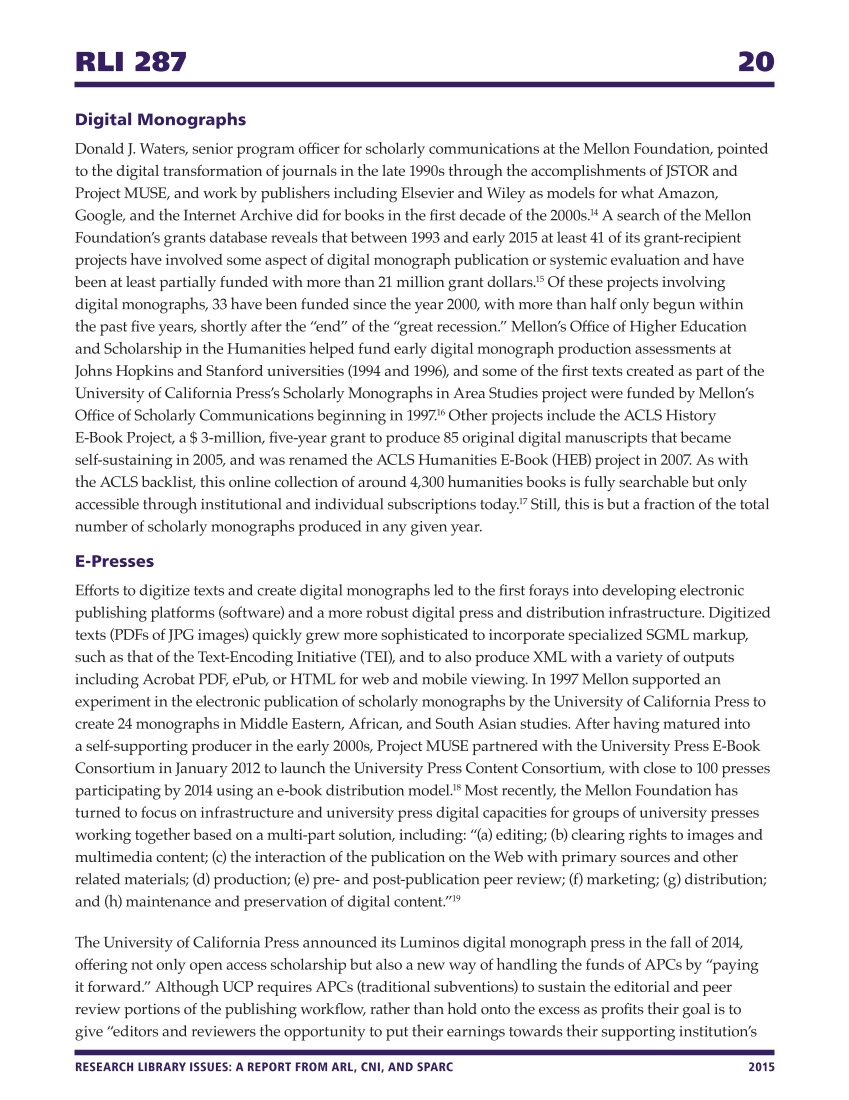RLI 287 20 RESEARCH LIBRARY ISSUES: A REPORT FROM ARL, CNI, AND SPARC 2015 Digital Monographs Donald J. Waters, senior program officer for scholarly communications at the Mellon Foundation, pointed to the digital transformation of journals in the late 1990s through the accomplishments of JSTOR and Project MUSE, and work by publishers including Elsevier and Wiley as models for what Amazon, Google, and the Internet Archive did for books in the first decade of the 2000s.14 A search of the Mellon Foundation’s grants database reveals that between 1993 and early 2015 at least 41 of its grant-recipient projects have involved some aspect of digital monograph publication or systemic evaluation and have been at least partially funded with more than 21 million grant dollars.15 Of these projects involving digital monographs, 33 have been funded since the year 2000, with more than half only begun within the past five years, shortly after the “end” of the “great recession.” Mellon’s Office of Higher Education and Scholarship in the Humanities helped fund early digital monograph production assessments at Johns Hopkins and Stanford universities (1994 and 1996), and some of the first texts created as part of the University of California Press’s Scholarly Monographs in Area Studies project were funded by Mellon’s Office of Scholarly Communications beginning in 1997.16 Other projects include the ACLS History E-Book Project, a $ 3-million, five-year grant to produce 85 original digital manuscripts that became self-sustaining in 2005, and was renamed the ACLS Humanities E-Book (HEB) project in 2007. As with the ACLS backlist, this online collection of around 4,300 humanities books is fully searchable but only accessible through institutional and individual subscriptions today.17 Still, this is but a fraction of the total number of scholarly monographs produced in any given year. E-Presses Efforts to digitize texts and create digital monographs led to the first forays into developing electronic publishing platforms (software) and a more robust digital press and distribution infrastructure. Digitized texts (PDFs of JPG images) quickly grew more sophisticated to incorporate specialized SGML markup, such as that of the Text-Encoding Initiative (TEI), and to also produce XML with a variety of outputs including Acrobat PDF, ePub, or HTML for web and mobile viewing. In 1997 Mellon supported an experiment in the electronic publication of scholarly monographs by the University of California Press to create 24 monographs in Middle Eastern, African, and South Asian studies. After having matured into a self-supporting producer in the early 2000s, Project MUSE partnered with the University Press E-Book Consortium in January 2012 to launch the University Press Content Consortium, with close to 100 presses participating by 2014 using an e-book distribution model.18 Most recently, the Mellon Foundation has turned to focus on infrastructure and university press digital capacities for groups of university presses working together based on a multi-part solution, including: “(a) editing (b) clearing rights to images and multimedia content (c) the interaction of the publication on the Web with primary sources and other related materials (d) production (e) pre- and post-publication peer review (f) marketing (g) distribution and (h) maintenance and preservation of digital content.”19 The University of California Press announced its Luminos digital monograph press in the fall of 2014, offering not only open access scholarship but also a new way of handling the funds of APCs by “paying it forward.” Although UCP requires APCs (traditional subventions) to sustain the editorial and peer review portions of the publishing workflow, rather than hold onto the excess as profits their goal is to give “editors and reviewers the opportunity to put their earnings towards their supporting institution’s


























